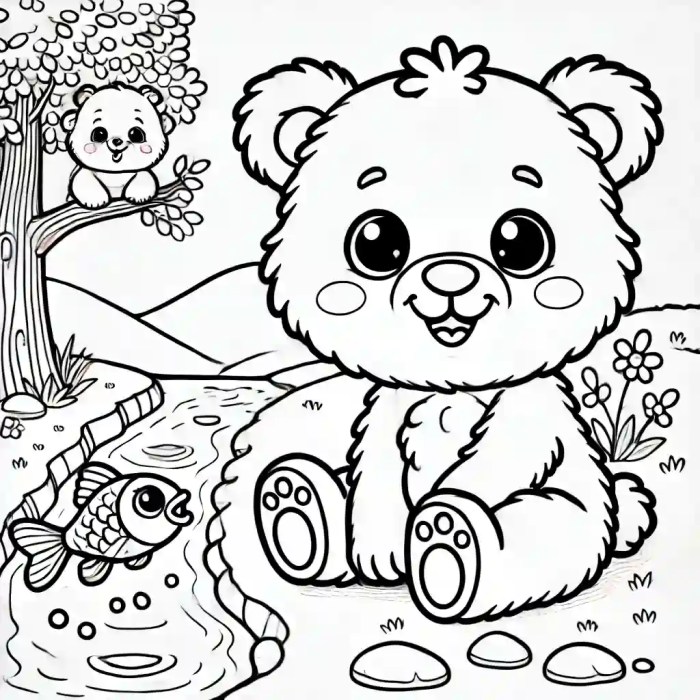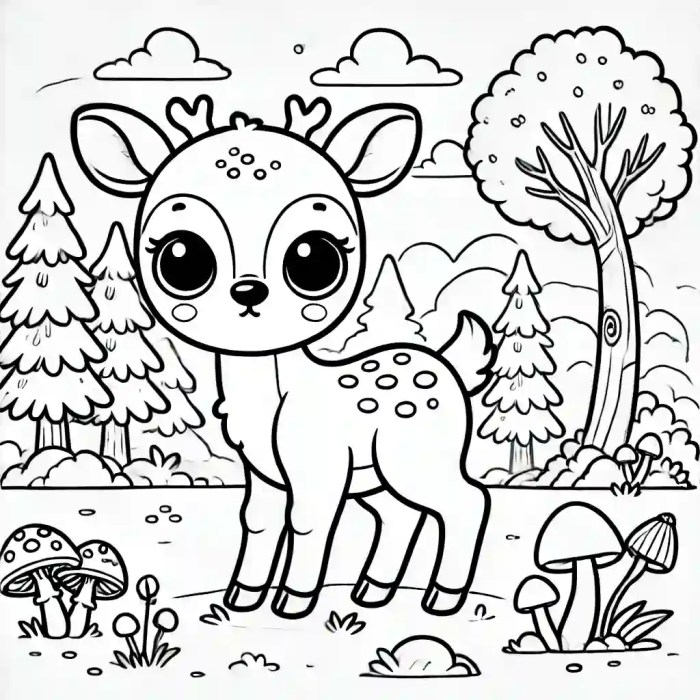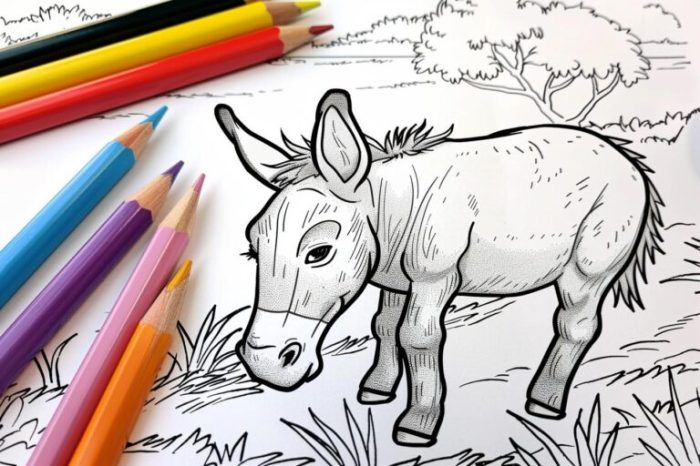Popularity and Trends

Animal coloring page kids – Animal coloring pages for kids remain incredibly popular, providing a creative outlet for self-expression and a relaxing activity for children of all ages. Their enduring appeal stems from their accessibility, affordability, and the inherent joy of bringing images to life with color. The market is constantly evolving, reflecting changing trends in children’s interests and design aesthetics.
Animal coloring pages for kids are a fun and educational activity, offering a creative outlet while subtly introducing concepts about the natural world. For a slightly more advanced learning experience, you might consider exploring the intricacies of cellular biology with resources like animal cell coloring pages , which can help bridge the gap between simple drawings and complex biological structures.
Returning to the simpler pleasures, however, animal coloring pages remain a fantastic way to spark a child’s imagination.
Current Popularity of Animal Coloring Pages
The popularity of animal coloring pages is consistently high, driven by several factors. Firstly, they offer a screen-free activity in an increasingly digital world, providing a valuable break from electronic devices. Secondly, the wide variety of animal themes caters to diverse interests, ensuring there’s something for every child. Finally, the tactile nature of coloring – the feel of crayons or colored pencils on paper – offers a sensory experience that digital activities often lack.
This popularity is evident in the continued strong sales of coloring books and the vast online availability of printable pages. Many websites and blogs dedicate significant resources to providing free and paid animal coloring pages, indicating substantial demand.
Emerging Trends in Children’s Coloring Page Designs
Three notable trends are shaping the design of children’s animal coloring pages. Firstly, there’s a growing emphasis on intricate and detailed designs, moving beyond simple Artikels to incorporate complex patterns and textures. This caters to older children seeking more challenging and rewarding coloring experiences. Secondly, the incorporation of educational elements is becoming more common. Coloring pages might feature anatomical details of animals, their habitats, or facts about their behavior, seamlessly blending entertainment with learning.
Thirdly, the use of bold, vibrant colors and playful styles is increasingly prevalent, reflecting a trend towards brighter and more expressive designs. This caters to children’s preferences for visually stimulating and engaging content.
Popularity of Different Animal Themes, Animal coloring page kids
Farm animals and wild animals consistently rank among the most popular themes. Farm animals, such as cows, pigs, and sheep, often appeal to younger children due to their familiarity and perceived cuteness. Wild animals, including lions, tigers, and elephants, tend to be favored by slightly older children who are captivated by their exotic nature and power. However, the popularity of specific animals can fluctuate depending on current events, popular children’s media, and seasonal influences.
For example, a popular animated movie featuring a specific animal might lead to a surge in demand for coloring pages featuring that creature.
Seasonal Variations in Demand for Specific Animal Coloring Pages
Seasonal variations in demand are subtle but noticeable. For instance, during the winter holidays, animals associated with the season, such as reindeer, penguins, or polar bears, might see a temporary increase in popularity. Similarly, animals associated with spring, such as bunnies or butterflies, may experience higher demand during that time of year. These fluctuations are relatively minor compared to the overall consistent demand for animal coloring pages throughout the year, but they demonstrate a correlation between seasonal themes and coloring page preferences.
Design Elements and Aesthetics

Creating engaging and appealing animal coloring pages for children requires careful consideration of design elements and aesthetics. The visual appeal directly impacts a child’s interest and enjoyment, influencing how long they engage with the activity and the overall positive experience. Successful designs cater to different age groups and developmental stages, employing varying levels of detail and complexity.
Typical Design Elements in Successful Animal Coloring Pages
Several key design elements contribute to the success of animal coloring pages for children. Simple, clear Artikels are crucial, especially for younger children. These Artikels should be bold enough to be easily traced but not so thick that they overwhelm the image. The level of detail should be appropriate for the target age group; preschoolers benefit from simple shapes and large areas, while older children may enjoy more intricate designs.
Positive and appealing animal characters are essential, often featuring large, expressive eyes and friendly expressions. Incorporating familiar animals or those with appealing characteristics can enhance engagement. Finally, leaving sufficient white space around the animal prevents the design from feeling cramped and cluttered.
Example Designs for Different Age Groups
Preschool (Ages 3-5): A large, simplified Artikel of a friendly-faced puppy. The design features bold, curved lines and large areas for coloring, minimizing fine motor skill requirements. The puppy’s ears are oversized and its eyes are large and expressive, with simple details. The overall aesthetic is cheerful and uncomplicated.Elementary (Ages 6-12): A more detailed Artikel of a playful monkey swinging from a vine.
This design incorporates more intricate details like individual fingers and toes, leaves on the vine, and textural elements in the fur. The monkey’s pose is dynamic and engaging, adding a sense of action to the page. The level of detail encourages fine motor skill development and provides opportunities for creative color choices.Tween (Ages 12-14): An intricate design of a majestic lion with detailed fur, mane, and facial features.
This design features a more realistic style with subtle shading and textural variations. The complexity of the design allows for more nuanced color blending and shading techniques, appealing to older children’s developing artistic skills. The background might include a simple savanna landscape to further enhance the scene.
Color Palette Selection and Impact
The color palette plays a vital role in the appeal of animal coloring pages. Bright, vibrant colors are generally preferred for younger children, stimulating their creativity and visual engagement. For older children, a more varied palette that allows for shading and color mixing can be more appealing. Consider using complementary colors to create visual harmony, and avoid using too many colors that might overwhelm the design.
A well-chosen palette can enhance the overall mood and atmosphere of the coloring page, contributing to its overall attractiveness. For example, warm tones might be used for a friendly puppy, while cooler tones might be more suitable for a majestic lion.
Artistic Styles Suitable for Animal Coloring Pages
Choosing the right artistic style is crucial for creating appealing coloring pages. Different styles cater to different age groups and preferences.
| Artistic Style | Characteristics | Suitable Age Group | Example |
|---|---|---|---|
| Realistic | Detailed anatomy, accurate representation of animal features, potential for shading and texture. | Older children (Tweens and Teens) | A meticulously rendered wolf with detailed fur and musculature. |
| Cartoonish | Simplified features, exaggerated proportions, playful expressions, often vibrant colors. | Preschool and Elementary | A cute, round-faced panda with oversized eyes and a friendly smile. |
| Minimalist | Simple lines, limited detail, focus on basic shapes and forms, often monochromatic or using a limited color palette. | All ages | A stylized Artikel of a bird with only essential features, leaving much room for creative interpretation. |
| Geometric | Animal shapes constructed from geometric forms like squares, circles, and triangles. | Elementary and Tweens | A fox composed of various interconnected triangles, creating a textured and abstract effect. |
| Manga/Anime | Large eyes, expressive features, dynamic poses, often vibrant colors and bold Artikels. | Tweens and Teens | A stylized cat with large, expressive eyes and a sleek, dynamic pose. |
Illustrative Examples

These examples demonstrate how diverse and engaging animal coloring pages can be, catering to different age groups and skill levels. The line art complexity and suggested color palettes are designed to inspire creativity and provide a satisfying coloring experience.
Playful Monkey Swinging Through Trees
This coloring page features a mischievous monkey playfully swinging from branch to branch in a lush jungle setting. The line art utilizes varying line weights to create depth and texture; thick lines define the monkey’s body and limbs, while thinner lines depict the details of its fur and facial features. Leaves and vines are intricately detailed, offering opportunities for shading and pattern creation.
Color suggestions include vibrant greens and browns for the foliage, with bright yellows, oranges, and browns for the monkey’s fur, allowing for playful variations in tone and shade. The background could incorporate a gradient of blues and greens to enhance the jungle atmosphere.
Majestic Lion with Flowing Mane
This coloring page showcases a majestic lion, its mane flowing dramatically in the wind. The line art emphasizes the powerful musculature of the lion’s body and the intricate texture of its mane. Individual strands of hair are subtly suggested, providing a challenge for older children while remaining accessible to younger ones. Suggested color palettes range from warm golden browns and tans for the lion’s body to a rich, deep brown for its powerful mane, with highlights of lighter browns and oranges to capture the light.
A simple background of a golden savanna landscape would complement the majestic presence of the lion.
Friendly Farm Animals
This coloring page depicts a cheerful group of farm animals: a cow, a pig, a sheep, and a chicken. Each animal is given a distinct personality through its posture and facial expression. The cow is depicted chewing its cud, its udder gently Artikeld. The pig is shown rooting in the ground, with detailed wrinkles and folds in its skin.
The sheep has a fluffy coat suggested by short, textured lines, and the chicken is shown pecking at the ground, with its feathers delicately detailed. The line art is simple and clean, making it suitable for younger children. Color suggestions include realistic browns, pinks, and whites for the animals, with pops of color for the background, perhaps a vibrant green field or a bright blue sky.
Underwater Scene with Colorful Fish and Coral
This coloring page depicts a vibrant underwater scene teeming with life. The line art is significantly more intricate, featuring detailed coral formations with various textures and shapes. Numerous fish of different species are included, each with unique markings and fin details. Seaweed and other aquatic plants add to the complexity of the scene. This page is ideal for older children who enjoy detailed work.
Color suggestions include a wide range of vibrant hues, reflecting the diversity of the underwater world. The coral could be rendered in shades of pink, orange, purple, and red, while the fish could feature a variety of blues, greens, yellows, and oranges. Subtle shading and highlighting would enhance the three-dimensionality of the scene.
Top FAQs: Animal Coloring Page Kids
Are animal coloring pages suitable for toddlers?
Yes, simpler designs with large, easy-to-color shapes are ideal for toddlers. Focus on basic animal shapes and avoid intricate details.
Where can I find free printable animal coloring pages?
Many websites offer free printable animal coloring pages. A simple online search should yield numerous results.
What kind of paper is best for coloring pages?
Heavier weight paper, such as cardstock, is recommended to prevent bleed-through, especially with markers or crayons.
How can I make my own animal coloring pages?
You can create your own using drawing software or even hand-draw them and then scan them for digital use.
